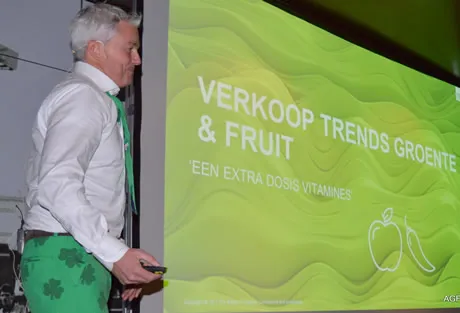Supermarkets reign supreme. Prices and margins are under pressure. Brands do not work for fresh fruit and vegetables. Sales growth at supermarkets is difficult. Things are looking gloomy in the sector. Is all this true?
When one looks are the hard figures, it can be seen that fresh fruit and vegetables are an extremely important category in supermarket sales. Marc Deij of the research company, Nielsen, presented these positive figures. He did so at the AGF Kennis(sen)dag (Fresh fruit and vegetable sector Knowledge and Acquaintance Day). This was held at the NAC stadium in the Netherlands. For this, he wore his lucky green trousers adorned with four-leaf clovers.

Nielsen collects 'till slips' from a large number of supermakets. All these till slips are a treasure trove of information and result in an enormous data base. Take, for example, a comparison between bananas as a healthy snack and the snack confectionery isle, where there are products such as Liga and Sultana. “This aisle has about 75 different products. With bananas, you can point out three different products", says Marc. All the cookies, together, yield a turnover of EUR124 million per year. This is a large amount. However, it is not even half of the EUR275 million that bananas bring into the supermarkets' cash drawers every year.
Fruit and vegetables have a good position within the snack segment, which is broader than just the cookie shelf. About a quarter of the EUR5,8 billion turnover that is recorded in this segment is thanks to fruit and vegetables. With this, these products hold second place just behind dry products. The snack segment grows by five percent annually. However, the sales of snack fruit and vegetables increase by an above-average rate of nine percent per year.

Cucumber sales = tea sales
This trend goes beyond the supermarkets. Retails sales also climb every year. However, this is mostly thanks to higher prices. Volumes have not increased over the last seven years, says Marc. Together, supermarkets have recorded revenues of almost EUR40 billion. In recent years, sales have increased by 3,5%. This is mainly due to higher prices. If you break down the trend, you will see that the fresh category is responsible for a 4,3% growth. Marc takes it a step further. Within the fresh category, fruit and vegetables is the only segment that has shown an increase. This increase is in volumes as well as prices.
Fruit and vegetables are becoming increasingly important for retailers' revenue. Between 2011 and 2018, sales rose by EUR1,3 billion. This may not seem like much, but if you take a closer look a the figures, you will see that certain products do better than entire categories. With EUR331 million, apples rank second behind lager, which is good for EUR996 million. Eric points out cucumber sales which, with EUR146 million, is more than the total sales of all varieties of tea.
Cucumbers also take the lead in the vegetable category, with the highest rise in revenue. Cucumbers reported a growth of 17% compared to the previous year. Apples take the lead among fruit. The increase in apple sales was mostly thanks to higher prices. Raspberries, mangoes, and blueberries are increasing thanks to higher volumes.
Strong labels within the fresh fruit and vegetable sector
Who says brands do not work in the fresh fruit and vegetable sector? A brand such as Kanzi has a turnover of EUR20 million. This is comparable to Brand and Peijnenburg. Zespri (EUR24 million) can hold a candle to Axe and Ben & Jerry’s, while Tommies (EUR25 million) is on the same level as Nutella and Cruesli. Those comparing Pink Lady, which is good for EU46 million in revenue, to brands from other categories, will end up looking at well-known names such as Oral B, Alpro, Duyvis, and Grand’Italia.
Is year-round availability really all that important? The sales figures show that products achieve a considerable part of their total turnover in the eight weeks of the year when their sales are highest. In the eight weeks when the most strawberries were sold, almost 40% of the annual turnover was achieved.
In closing, Marc pointed out a few trends that the sector can play in on. Regional differences also make up part of this. On 11 November, children in parts of the Netherlands go from house to house, carrying lanterns, and singing. This is done to honor St Maarten. The aim is to get as much candy as possible. Candy bar manufacturers picked up on this and sales spike in the week before the lantern parade. There is a similar increase in mandarin sales in the week before these festivities. Could this be possible for other products too?
What about the opportunities that are still there for the taking? On average, fruit and vegetables are good for 12% of a supermarket's sales. If 65% of Dutch supermarkets were to reach this standard, the total turnover would increase to EUR300 million.
Do you want to go through the slides in your own time? Please send an email to Marc at marc.deij@nielsen.com
